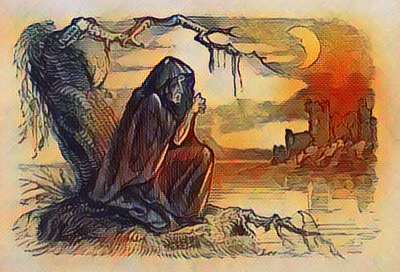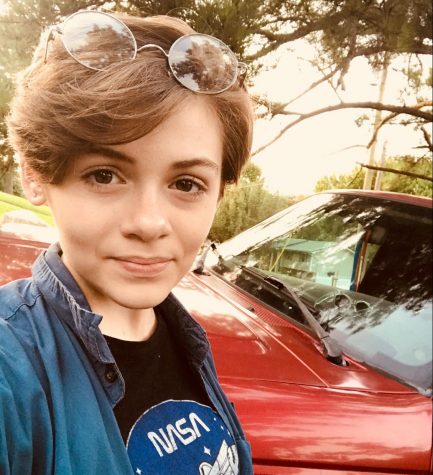TRICK OR TREAT?

E. Delaney
October 11, 2018
Every year on the 31st of October, children dress up in costumes and ask around their neighborhood for candy with the classic yet mystifying question, “Trick or treat?”
We all grew up with these traditions, although they are actually rather outlandish upon scrutinization. Who came up with the idea of Halloween with its free candy and costumes? Where did the widespread yet eccentric tradition originate, which cultures influenced its configuration, and what legends surround it?
There are many interpretations, myths, and tales surrounding the origins of and purposes for Halloween. Many cultures celebrate the holiday in different and unique ways; to some, Halloween is a frightful day with sinister connotations. For some, it is a fun day for crafts, costumes, and partying, while for others it is a sacred and joyful day. No one is quite sure exactly when, where, and why Halloween started, but there are a massive array of intriguing theories and lore.
American civilians typically celebrate Halloween as we at Heritage are accustomed to: cute, scary, or cool costumes; kids knocking on doors, people handing out candy, and spooky decorations. People have parties, tell scary stories, bond with family and friends, go to see a horror movie, or three. Many don’t celebrate Halloween at all.
We can trace the holiday back as far as a Celtic festival called Samhain, which was basically the Celtic New Year; it was the day, supposedly, when spirits of the dead could visit and be interacted with, according to UCLA mythology/folklore professor Peter Tokofsky. Samhain translates to “summer’s end.” The end of the summer harvest season marked the beginning of the cold, desolate winter season, which was widely associated by the Druids (Pagan Celts) with death and famine. This was probably the reason they thought the dead were near during this time.
The Druids constructed enormous bonfires and danced around them in hopes of encouraging sunlight and keeping evil spirits at bay, while keeping doors open so that the spirits of their passed loved ones might commune with them. They wore costumes, animal skins, dressed as witches, goblins, and other things in order to avoid possession, and they participated in fortune telling as well as animal and crop sacrifices. The Druids, in costume, asked for food, and if this request was not met, they made mischief. They were treated or they tricked.
The Roman culture began to overtake the Druidic traditions around 43 AD when most of the Celtic territory was conquered by the Romans. They entertained two festivals, including Feralia and Pomona, the first honoring the dead, and the latter commemorating their goddess of fruits and trees, who may have contributed the practice of bobbing for apples.
In the Old World, the holiday was made official by Pope Gregory IV, transforming old Pagan traditions into a more modern incarnation called All Saints Day. Christianity influenced the new ways, and the act of going from door to door to beg for food (called soul cakes) to give the poor was established. People dressed up in gruesome costumes to symbolize the dreadful deaths of the Seven Brethren, who were told about in the Book of Maccabees, which was one of the books left out of the Bible. The Brethren, a group of rebels, died horrible deaths as martyrs in the historical account.
The European tradition was shaken up when American Colonists began to blend their All Saints Day with the natives’ harvest celebrations. The natives’ practices included telling chilling tales of troublesome spirits and the dead. Later, Irish immigrants flooded into America, fleeing Ireland’s potato famine in 1846, and soon, by the blending of Irish and American practices, Halloween was on its way to become what we celebrate nowadays, bringing the idea of “trick or treat” to life.
In Mexico, Latin America, and Spain, the people celebrate All Souls Day on November 2nd. It consists of three days of celebration beginning on October 31st. Mexico is the home of the legend of La Llorona, the tragic tale of a woman’s demise. It is often told that La Llorona, after discovering her husband cheating, drowned her three children and then herself. To this day, she is said to roam rivers on Halloween, and you can supposedly still hear her calling for her lost children.
The Irish have legends about kniving Leprechauns and their alternative cousin, the Far Darrig, or the “Red Man,” who dresses in red and gives victims blood-curdling night terrors to amuse himself. They also tell of the Bean Sidhe, or as we know her, the Banshee, who arrives to haunt noble families just before a death occurs within them. She is said to resemble ancient mourners, who families would hire to lament their losses, and Banshee screeches serve as warning, heralding approaching death. Banshee is considered to be harmless, but it is rumored that she has a sister spirit who is not. Another Irish legend talks about changelings; changelings are creatures that change places with attractive baby boys, and the real ones are stolen by the “Good People” who use the stolen child as a mate for their Queen. The changelings are said to have a huge appetite, a mean spirit, and harsh voices. People would often dress their baby boys as girls to keep the Good People from taking them.
The French also have many intriguing legends about Halloween creatures and happenings. The first is one about the Dames Blanches, or the “white woman.” She is a female ghost, completely engulfed in white light; she is generally nonmalignant, but if you fail to comply with her will, there is no telling what she may do. The next is a Matagot, or a spirit in animal form. These are said to be evil, but they can also bring wealth and fortune if adopted and kept healthy, happy, and well-fed. Then you have the Loups garous, or as we know him, the werewolf. This one is different, however, in that they can change into their wolf form at will and are fully aware while in that state, so there is as little mischief as the creature wishes. The Feu Follet is possibly the most enchanting force of them all, often compared to will-o-the-wisp. It is a strangely tinted fog or mist that usually appears at swamps or cemeteries. Feu Follet are generally quite docile, but it is said that the mist is made up of spirits who, if you follow them, will lead you to your death.
Many cultures have influenced the forming of the scary yet beloved holiday. It has evolved over many, many decades, but Halloween as a holiday has never lost its unique quality. Going out on Halloween night in costume to ask for candy with that signature phrase is a practice that many participate in, but few know why they do. There is much speculation surrounding Halloween, and this year I’ll celebrate it with more knowledge as to why. From the Celtic festival of Samhain, to the Roman holidays of Feralia and Pomona, to the Catholic All Saints Day, and then to American-Indian influence combined with Irish traditions, Halloween is overflowing with rich culture. It has and always will be dear to the hearts of many, and we will continue to celebrate the spooky holiday for many years to come.
